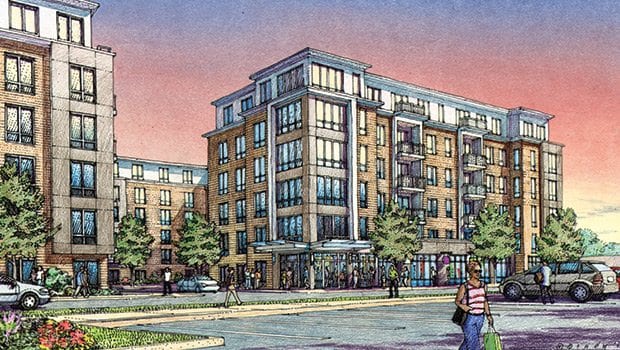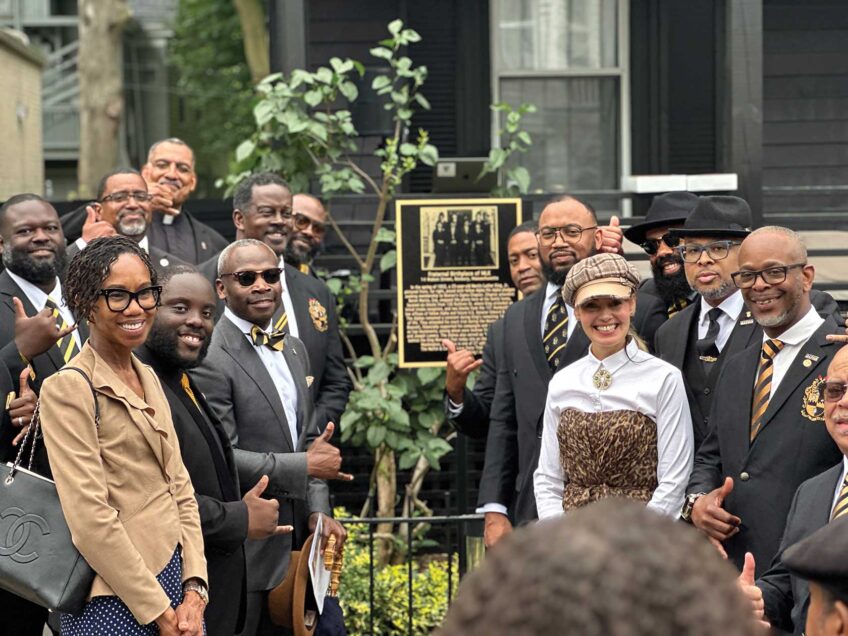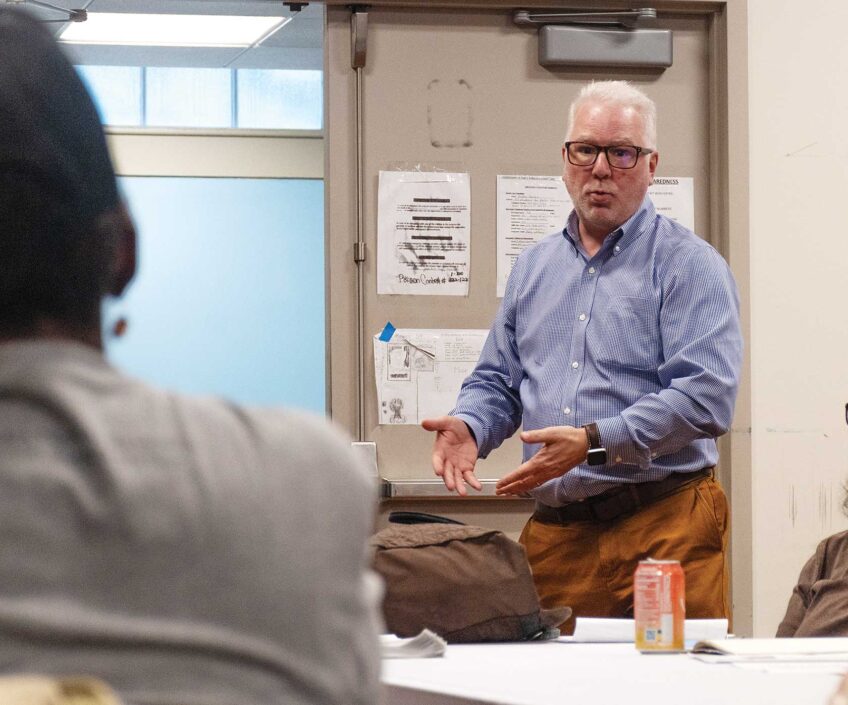Two developers plan housing, retail for Mattapan Square bus and trolley station parking lot

Two developer teams are vying to bring housing and retail to the vacant MBTA-owned parking lot by the Mattapan Square bus and trolley station.
“[Redevelopment] is a great opportunity for what has been a lifeless, vacant parking lot to become a positive gateway into Mattapan Square,” said state Rep. Dan Cullinane. The property’s close proximity to public transit and the Main Streets district are particular attractions.
Trinity Financial teamed up with Codman Square Neighborhood Development Corporation on a proposal, while Preservation of Affordable Housing Inc. and Nuestra Comunidad Development Corporation partnered on their own proposal. Both plans provide retail space and affordable and market rate housing on the approximately 2.5 acres of land on River Street. The minimum sales price for the land on the MBTA’s request for proposals is $1.5 million.
In 2014, the MBTA was close to selling the property to a charter school, but halted the process and re-issued an RFP after protest came over lack of community involvement in the decision.
Mixed-income housing
Trinity Financial and Codman Square NDC’s plan provides more housing and less retail than their competitors. Trinity-Codman propose to create a three-building complex, each section six-stories tall, containing a total of 267 housing units and 4,500 square feet of retail space. Approximately 75 percent of the units will be affordable to those making up to 60 percent of the Area Median Income.
During phase one, 101 affordable and 25 market rate rental units would be built, said Mathieu Zahler, senior project manager for Trinity. Ninety-four affordable rental units would be introduced in Phase 2A, and 47 condos for sale in Phase 2B. Plans call for 153 residential parking spaces, with an additional 50 parking spaces for commuters/visitors required by the RFP.
Housing is in high demand in the community, especially among young adults looking to stay in the neighborhood they grew up in, who are often forced out due to high rents, said Cullinane.
“What we need in Mattapan is housing. Right now rents are going up because there isn’t enough housing supply, ” he said. “It’s not just about the number of units, it’s about creating a real mixed-income community … of all levels of affordability,” he added.
Preservation of Affordable Housing Inc. and Nuestra Comunidad propose to provide135 units of housing in two buildings, along with 10,000 square feet of retail. Fifty-two percent of the housing units would be affordable to those making up to 60 percent AMI. In addition to the 50 required commuter parking spaces, there will about 94 residential parking spaces, Nuestra Executive Director David Price said.
Part of the decision to build housing at lower-density was to provide for open community space, Price said. “We’re trying to create generous public space where there can be opportunities for the community.” As examples, Price suggested the Mattapan farmer’s market and a walking path could be sited there.
Retail offerings
While Trinity Financial’s plan offers more housing, POAH-Nuestra’s would provide more than double the retail space.
“We heard from residents we met with, both one-on-one and in groups, that there is a strong desire for more retail in Mattapan Square,” Price said. “We programmed as much retail space as we could .”
Price said POAH and Nuestra look to fill empty niches on the retail scene, which could mean sit-down restaurants open at night, a gym and a café where youth could gather, socialize and work. The partners also are open to the idea of a community program occupying some of the retail space.
In Mattapan, there are few restaurants where families can dine in the evening, Cullinane said. Other needs include a café and coffee shop, breakfast place and healthy food options. What is not needed, he said: another cell phone retailer or liquor store.
“If you put in full day’s work, come home and want to take family out to dinner, the square is for large part shut down during evening hours,” Cullinane said. “If you come home and want to spend a dollar in your community, there’s really not an opportunity most days of the week to do so.”
Zahler said the Trinity-Codman team would defer to the community about what businesses should occupy the retail space, and he and Codman NDC Executive Director Gail Latimore added that they are concerned that any retail complement, not compete with, existing businesses in Mattapan Square.
Transit factor
Codman’s Latimore said that her organization is drawn to the Mattapan Square station site in large part because of the proximity to public transit. Codman NDC is part of the Fairmount/Indigo Corridor Collaborative — a coalition of neighborhood CDCs that have been working for over a decade to bring transit equity along the Fairmount Line corridor. The coalition seeks to ensure that as service improvements come to the line, current residents are served by the new transit opportunities, not displaced as those assets attract newcomers.
“Transit is the number one aspect in neighborhoods gentrifying,” Latimore said. “We were concerned about that.”
To combat displacement, the coalition has been working to create affordable housing in the Fairmount corridor, and building such housing in Mattapan is part of those goals.
In addition, the MBTA is reviewing Mattapan’s high-speed trolley line and considering its future. Last week elected officials wrote to the MBTA, asking for a $3 million allocation to maintain the trolley line as is, while cautioning against proposals for converting the line to shuttle bus service.
Zahler said the Trinity-Codman plan cannot go forward if the trolley service is discontinued, according to the Dorchester Reporter.
“Having a trolley there and connection to a bus station integrates this [development] further into the overall transit system and makes it a compelling place to live and to be,” he told the Banner.
“In both of these proposals, what is glaring is how critical the future of the Mattapan high-speed trolley line is to any economic development in the area,” Rep. Cullinane noted.
Experience
Both teams cite a history in Mattapan or with similar projects.
Trinity Financial carried out several previous projects in the neighborhood, along with three projects with the MBTA and MassDOT, Zahler said. Trinity’s partner, Codman, has had a presence in portions of Mattapan for about 25 years, has 101 housing units in the neighborhood and has worked with Mattapan organizations, Latimore said.
“This is a chance to leverage our experience doing transit-oriented development and to work with the Mattapan community again,” Zahler said.
Meanwhile, POAH’s work includes housing developments in various cities, with three 145-200 unit rehabilitation projects in other Boston neighborhoods. Price said Nuestra has owned a 96-unit apartment building on River Street for a dozen years and is involved with local community groups. Nuestra also is currently developing a former MBTA bus yard in Roxbury.
“We’ve been active in the neighborhood. We know the concerns the neighbors have about that lot and the potential it has,” Price said.






